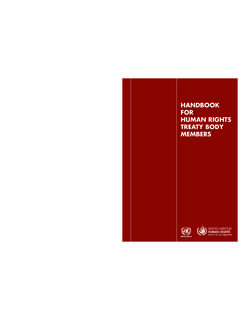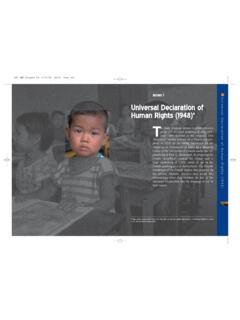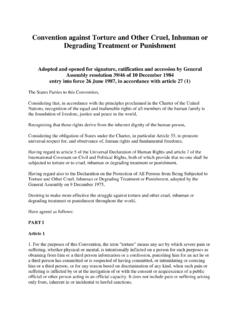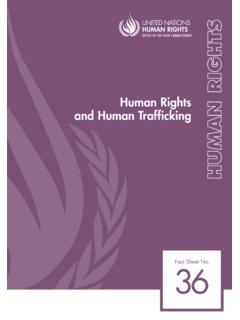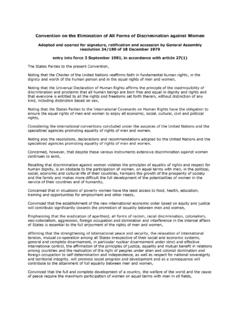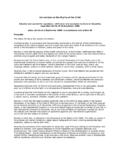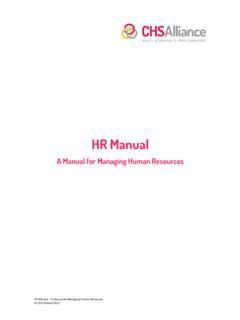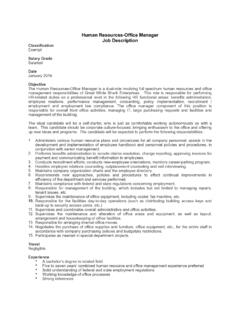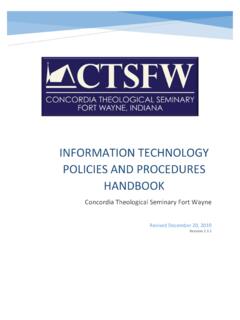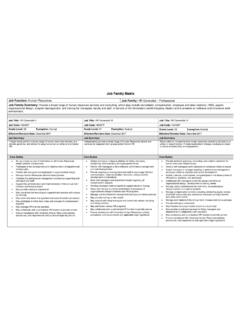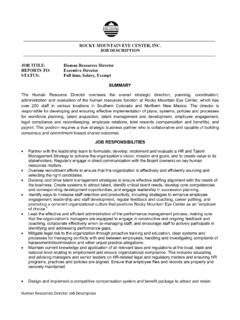Transcription of A Guide for Business How to develop a Human rights Policy
1 A G u i d e f o r B u s i n e s s How to develop a Human rights Policy AcknowledgementsAuthor: Lucy Amis Research assistance: Anita Househam Design: Tannaz Fassihi Printing: ISBN: united nations Global Compact office and office of the united nations High Commissioner for Human rights , 2011 The Global Compact Office and the Office of the United Nations High Commissioner for Hu-man rights (OHCHR) make no representation concerning, and do not guarantee, the source, originality, accuracy, completeness or reliability of any statement, information, data, finding, interpretation, advice or opinion contained within the publication is intended strictly as a learning document. The company examples used represent a possible good practice approach on the particular identified topic. The inclusion of any particular example does not in any way constitute an endorsement by the United Nations Global Compact and/or OHCHR of the company concerned or its corporate responsibility performance overall.
2 The designations employed and the presentation of the material in this publication do not imply the expression of any opinion whatsoever on the part of the Secretariat of the United Nations concerning the legal status of any country, territory, city or area, or of its authorities, or concerning the delimitation of its frontiers or nations Global Compact TThe United Nations Global Compact is a strategic Policy initiative for businesses that are committed to aligning their operations and strategies with ten universally accepted principles in the areas of Human rights , labour, environment and anti-corruption ( ).By doing so, Business , as a primary agent driving globalization, can help ensure that markets, commerce, technology and finance advance in ways that benefit economies and societies everywhere. The United Nations Global Compact has two objectives: 1. Mainstream the ten principles in Business activities around the world; 2. Catalyse actions in support of broader United Nations goals, including the Millennium Development Goals (MDGs).
3 The office of the united nations High Commissioner for Human rightsThe Office of the United Nations High Commissioner for Human rights (OHCHR) is a key branch of the United Nations Human rights structure. The High Commissioner is respon-sible to the United Nations Secretary-General for encouraging the international community and States to uphold universal Human rights standards. OHCHR seeks to work with an ever wider range of actors, including the private sector, to promote respect for and commitment to Human rights as widely as possible. OHCHR serves as secretariat for the United Nations intergovernmental body on Human rights , the Human rights Council. OHCHR has supported the Human rights component of the United Nations Global Compact since it was launched in in summaryWhy respect Human rights ? All companies have a responsibility to respect Human rights , which means to avoid infring-ing on the Human rights of others. To gain commercial benefits associated with good Human rights practice, , attracting investment, procurement, top-quality recruits and securing the social licence to operate.
4 To live up to the company s commitment to the United Nations Global Compact (if it is a participant).Why develop a Human rights Policy ? To provide a basis for embedding the responsibility to respect Human rights through all Business functions. To respond to relevant stakeholder expectations. To identify Policy gaps and initiate a process that alerts the company to new areas of Human rights risk. To elaborate on the company s commitment to support Human rights . To build increased trust with external stakeholders and to start to understand and address their concerns. To foster the development of in-house learning, management capacity and leadership on Human rights issues. To demonstrate international good Business started - the process behind the Policy Developing a Human rights Policy can be a dynamic, though not always a predictable process. Do not expect perfection at first. Many firms update their policies as they gain experience.
5 Assign senior management responsibility to drive the process. Involve all Business operations in Policy development, implementation and reviews. Map existing company policies to identify Human rights coverage and gaps. Involve cross-functional personnel ( Human resources, legal, procurement, security, etc.) in the process to build understanding, know-how and a sense of common purpose. Consult internal and external stakeholders to identify and respond to their are the key ingredients of a Human rights Policy ? All policies whether stand-alone or integrated should at a minimum comprise: An explicit commitment to respect all Human rights which refers to international Human rights standards, including the Universal Declaration of Human rights . Provisions on labour/workplace rights . Provisions on non-labour rights . These will reflect Human rights priorities and are likely to be particular to the company s industry/areas of operation.
6 Next steps - Path to implementation Assessing the company s Human rights impacts and risk areas, including country analyses, new operation assessments and stakeholder consultation. Integrating Human rights throughout the company, looking at training, communication, management systems, etc. Tracking and communicating on performance, including by identifying progress measure-ment indicators. Providing for or cooperating in remedying an adverse Human rights situation that a company has caused or contributed to through legitimate processes. Establishing or participating in effective operational-level grievance mechanisms for individuals and communities that may be adversely affected by the company s A Guide for Business How to develop a Human rights Policy 1. Overview - what is a Human rights Policy ? A Human rights Policy can take many forms and has no uniform definition. At a minimum, it is a public statement adopted by the company s highest governing authority committing the company to respect international Human rights standards and to do so by having policies and processes in place to identify, prevent or mitigate Human rights risks, and remediate any ad-verse impact it has caused or contributed to.
7 It should explicitly use the words Human rights . Many Human rights policies also elaborate on the company s commitment to support Human Human rights policies can be found within company statements of Business principles, codes of conduct or other values-related literature, or take the form of stand-alone statements on company websites or in other public corporate responsibility Adopting a Human rights Policy is a precursor to a company s Human rights due diligence towards meeting its responsibility to respect Human rights . It sends a clear signal to internal and external stakeholders that the company is striving to embed Human rights into its opera-tional policies and procedures and to understand the Human rights impacts of the Business , both positive and negative. It also signals a commitment to take respect for Human rights suf-ficiently seriously to allocate management time and resources to developing and implementing a Policy , including by consulting externally.
8 A Guide for Business : How to develop a Human rights Policy seeks to outline why companies should respect Human rights , the principal reasons for adopting a Human rights Policy , its key ingredients and the best-practice process to develop Global Compact Principle One asks companies to respect and support Human rights . 2. For example, CNOOC included a statement on how it views Human rights issues in its overseas operations in its 2009 Corporate Social Responsibility report, available from (accessed 15 April 2011). 52. Why respect Human rights ?suMMArY All companies have a responsibility to respect Human rights , which means to avoid infringing on the Human rights of others. To gain commercial benefits associated with good Human rights practice, , attracting investment, procurement, top-quality recruits and securing the social licence to operate To live up to the company s commitment to the United Nations Global Compact (if it is a participant).
9 Values: a universal responsibility Companies have a responsibility to respect international Human rights standards, which means not to infringe on people s rights and to address adverse Human rights impacts that they cause or contribute This universal responsibility is articulated in the Protect, Respect and Remedy framework, welcomed by the United Nations Human rights Council in 2008. In 2011, Guiding Principles addressed to both Governments and Business on how to implement the framework, including the responsibility of Business to respect Human rights , were endorsed by the Human rights Council. The endorsement established the Guiding Principles as the authoritative global refer-ence point for Business and Human rights . The framework, which has widespread support from Business and civil society, implies that companies must have a Human rights Policy to embed Human rights within their operational policies and procedures. Report of the Special Represen-tative of the Secretary-General on the issue of Human rights and transnational corporations and other Business enterprises, John Ruggie, Guiding Principles on Business and Human rights : Implementing the United Nations Protect, Respect and Remedy Framework (A/HRC/17/31) This responsibility to respect Human rights is incorporated in Principle One of the United Nations Global Compact.
10 Commercial Many firms believe that showing respect for Human rights gives them a competitive advantage over competitors that overlook the area. Exercising Human rights due diligence can help com-panies attract investment. Investment that favours good environmental, social and corporate governance is expanding5 and being mainstreamed, with asset managers like BlackRock, AXA Investment Manager, Calvert and HSBC all now offering funds with such criteria, some cover-ing Human rights . Indices like the FTSE4 Good and Dow Jones Sustainability Index have strict Human rights entry And some national State pension funds and major public sector funds also screen on labour and Human rights , , the United States teachers and researchers pension fund TIAA-CREF (US$ 314 billion) and the Norwegian Government Pension Fund (US$ 380 billion). 3. According to the Report of the Special Representative of the Secretary-General on the issue of Human rights and transnational corporations and other Business enterprises, John Ruggie, Protect, respect and remedy: a framework for Business and Human rights , doing no harm is not merely a passive responsibility for firms but may entail positive steps for example, a workplace anti-discrimination Policy might require the company to adopt specific recruitment and training programmes (A/HRC/8/5).

